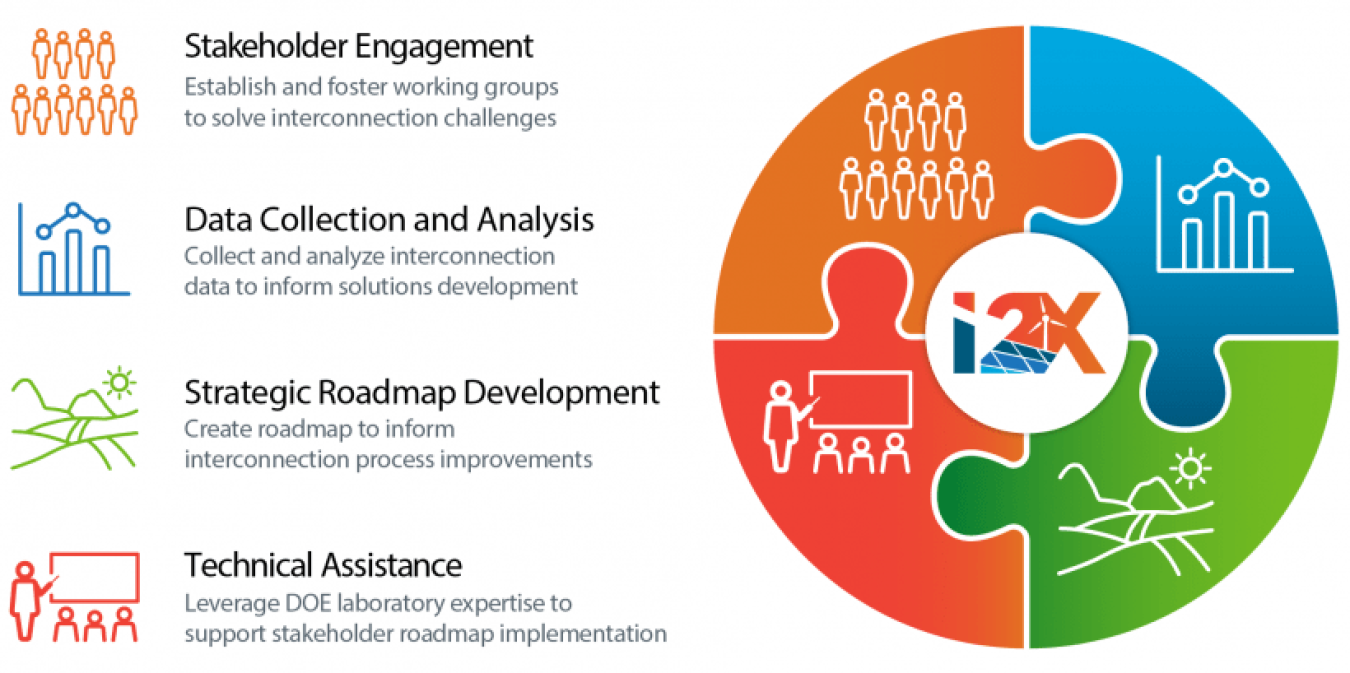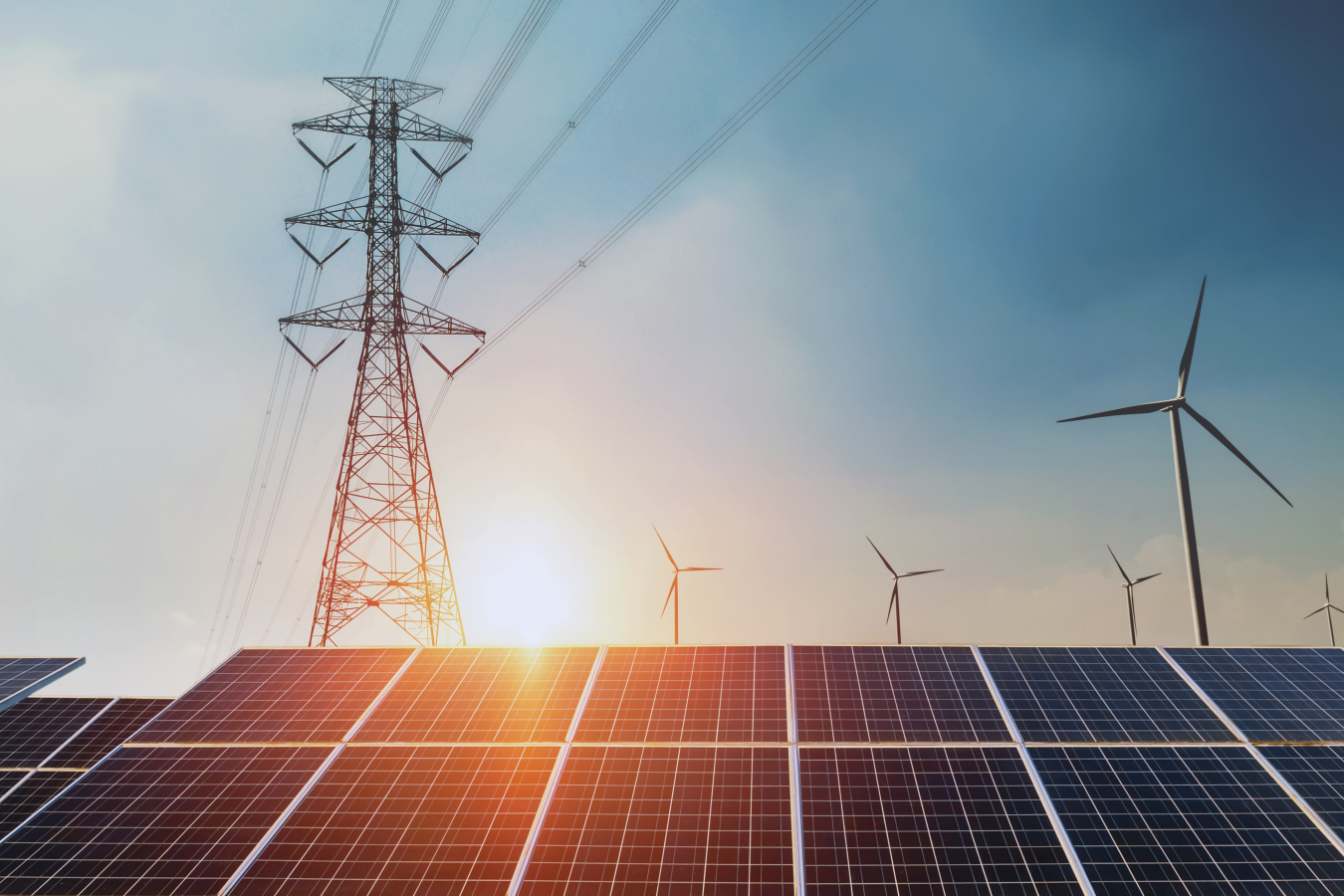Electric transmission system operators are responsible for transporting energy from its source to customers regionally or nationally. Before connecting energy from the source to the electric grid, operators conduct a series of impact studies that establish what new transmission equipment or upgrades may be needed.
The lists of projects in this process are known as “interconnection queues.” Entering an interconnection queue is just one of many steps in the renewable energy development process. Project developers must also have agreements with landowners and communities, power purchasers, equipment suppliers, and financiers, and may need to enhance their local transmission grid infrastructure.
There are now more than 1,300 gigawatts (GW) of solar power, wind energy, and battery capacity seeking grid interconnection, but these projects face long wait times and, in many cases, high costs to upgrade and connect to the grid system.
Helping Renewable Energy Resources Connect to the Grid
The U.S. Department of Energy (DOE) has partnered with research teams from the Pacific Northwest National Laboratory, Lawrence Berkeley National Laboratory, and National Renewable Energy Laboratory to launch a new initiative—the Interconnection Innovation e-Xchange (i2X). This initiative is designed to help clean energy resources connect to the grid, which will enhance overall grid reliability and improve market competition, transmission, and distribution access.
The i2X program brings together partners to develop solutions for faster, simpler, and fairer interconnection of clean energy resources while boosting the reliability, security, and resiliency of the electric grid. This will be accomplished through a stakeholder engagement platform, better data and analysis, roadmap development, and technical assistance.
The i2X program aims to:
- Solve core issues surrounding grid interconnection, such as a lack of data, shortage of a skilled workforce, and administrative barriers that result in inefficient connection procedures
- Provide technical assistance to partners to develop solutions to specific regional, state, and local interconnection issues, helping connect more clean energy to the grid and lowering costs for consumers and families
- Address the inequities caused by interconnection in alignment with the Biden administration’s Justice40 Initiative.

The Interconnection Innovation e-Xchange (i2X) convenes diverse stakeholders involved in the interconnection of solar energy, wind energy, and energy storage resources to facilitate peer learning and knowledge exchange and inspire new interconnection ideas and capabilities.
The Increasing Amount of Energy Capacity Seeking Transmission Interconnection
The total energy capacity seeking transmission interconnection has increased dramatically over the last decade, reaching a peak at the end of 2021 at around 1.4 terawatts (TW), which is greater than current U.S. generating capacity of 1.2 TW and a full terawatt higher than the queue in 2010.
“The sheer volume of clean energy capacity in the queues is remarkable,” said Joseph Rand, senior scientific engineering associate at Lawrence Berkeley National Laboratory. “It suggests that a huge transition is underway, with solar and storage taking a lead role.”
As of the end of 2021, solar power accounted for the largest share of generating capacity in the queues (676 GW), but substantial wind energy capacity (247 GW) also applied for interconnection. The amount of offshore wind energy capacity in the queues (77 GW) represents more than twice the Biden administration’s goal of 30 GW installed by 2030, though these proposed offshore wind projects may face interconnection challenges resulting from the lack of existing infrastructure. Developer interest in electricity storage has exploded in recent years, with capacity in the queues doubling in just one year, up to 427 GW.
Rand points out that the amount of solar power, wind energy, and energy storage in the queues today is roughly the same amount needed to reach 80% of U.S. electricity from zero-carbon resources by 2030. President Biden has set ambitious goals to create a carbon-pollution-free power sector by 2035 and a net-zero-emissions economy by no later than 2050 to combat climate change.
“The trends in these interconnection queues suggest that developers are eager to meet this ambition, though they may face some headwinds,” Rand said.
This is also true for renewable projects interconnecting to local distribution grids.
“The National Renewable Energy Laboratory has stated that distributed ‘behind-the-meter’ wind power generation could provide over 1,400 gigawatts of capacity in 2035 if siting and interconnection requirements are simplified,” said Robert Wills, board member at the Distributed Wind Energy Association. Behind-the-meter distributed wind energy systems are connected to the grid on the customer’s side and generate electricity to be used by homes or buildings on site. “Presently, distributed wind installers face many barriers to installation and have no recourse or path to resolution when faced with interconnection issues. The Distributed Wind Energy Association sees the i2X program as a positive way to move forward with this very important clean-energy sector.”

The Interconnection Innovation e-Xchange (i2X) is designed to help clean energy resources connect to the grid, which will enhance overall grid reliability and improve market competition and transmission and distribution access.
Growing Challenges Highlight the Need to Improve Processes
Current costs and procedures for connecting to the grid cannot accommodate the rapid increase in clean energy projects, resulting in lengthy interconnection wait times, many projects withdrawing from interconnection queues prior to being completed, and uncertainty for project developers.
And with the clean energy investments in both the Bipartisan Infrastructure Law and Inflation Reduction Act, even more clean energy sources will join the queue for grid integration.
Withdrawal rates and wait times in the queues suggest growing interconnection and transmission challenges and highlight the need to improve institutional processes. In July 2021, the Federal Energy Regulatory Commission released an Advanced Notice of Proposed Rulemaking to study and address many of these issues, followed by a Notice of Proposed Rulemaking focused on transmission planning in April 2022 and a second NOPR focused on generator interconnection reforms in June 2022.
Collaborating with participating i2X organizations, experts from DOE’s Wind Energy Technologies and Solar Energy Technologies offices, Pacific Northwest National Laboratory, National Renewable Energy Laboratory, and Lawrence Berkeley National Laboratory will develop a 5-year roadmap that sets goals and identifies research gaps and benchmarks for success.
These efforts are expected to inform and complement the Federal Energy Regulatory Commission's Notice of Proposed Rulemaking proceedings and National Association of Regulatory Utility Commissioners’ efforts to inform and assist state regulators.
"We have the potential to meet the Biden-Harris administration's goal of a carbon-free electricity grid by 2035 if we strategically harness our existing renewable energy resources," Rand said. "Support from the Bipartisan Infrastructure Law and Inflation Reduction Act, combined with the ambitious objectives of the i2X exchange, can expedite our journey to a clean energy future."
Learn more about i2X and sign up to be an i2X partner.
Subscribe to the WETO e-newsletter to stay informed on the latest wind energy news, events, publications, and updates.
